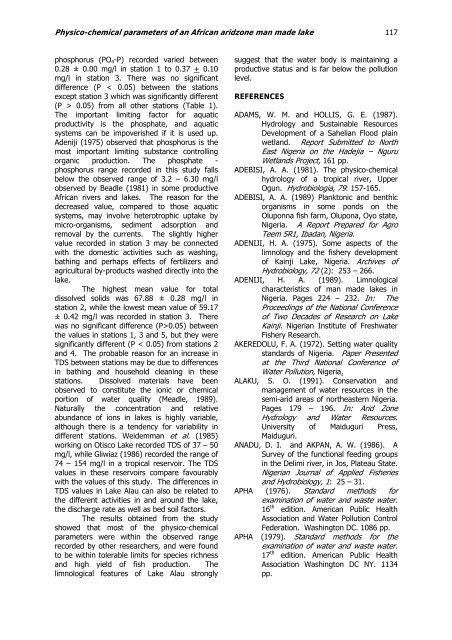ARI Volume 1 Number 2.pdf - Zoology and Environmental Biology ...
ARI Volume 1 Number 2.pdf - Zoology and Environmental Biology ...
ARI Volume 1 Number 2.pdf - Zoology and Environmental Biology ...
You also want an ePaper? Increase the reach of your titles
YUMPU automatically turns print PDFs into web optimized ePapers that Google loves.
Physico-chemical parameters of an African aridzone man made lake<br />
phosphorus (PO4-P) recorded varied between<br />
0.28 ± 0.00 mg/l in station 1 to 0.37 + 0.10<br />
mg/l in station 3. There was no significant<br />
difference (P < 0.05) between the stations<br />
except station 3 which was significantly different<br />
(P > 0.05) from all other stations (Table 1).<br />
The important limiting factor for aquatic<br />
productivity is the phosphate, <strong>and</strong> aquatic<br />
systems can be impoverished if it is used up.<br />
Adeniji (1975) observed that phosphorus is the<br />
most important limiting substance controlling<br />
organic production. The phosphate -<br />
phosphorus range recorded in this study falls<br />
below the observed range of 3.2 – 6.30 mg/l<br />
observed by Beadle (1981) in some productive<br />
African rivers <strong>and</strong> lakes. The reason for the<br />
decreased value, compared to those aquatic<br />
systems, may involve heterotrophic uptake by<br />
micro-organisms, sediment adsorption <strong>and</strong><br />
removal by the currents. The slightly higher<br />
value recorded in station 3 may be connected<br />
with the domestic activities such as washing,<br />
bathing <strong>and</strong> perhaps effects of fertilizers <strong>and</strong><br />
agricultural by-products washed directly into the<br />
lake.<br />
The highest mean value for total<br />
dissolved solids was 67.88 ± 0.28 mg/l in<br />
station 2, while the lowest mean value of 59.17<br />
± 0.42 mg/l was recorded in station 3. There<br />
was no significant difference (P>0.05) between<br />
the values in stations 1, 3 <strong>and</strong> 5, but they were<br />
significantly different (P < 0.05) from stations 2<br />
<strong>and</strong> 4. The probable reason for an increase in<br />
TDS between stations may be due to differences<br />
in bathing <strong>and</strong> household cleaning in these<br />
stations. Dissolved materials have been<br />
observed to constitute the ionic or chemical<br />
portion of water quality (Meadle, 1989).<br />
Naturally the concentration <strong>and</strong> relative<br />
abundance of ions in lakes is highly variable,<br />
although there is a tendency for variability in<br />
different stations. Weidemman et al. (1985)<br />
working on Otisco Lake recorded TDS of 37 – 50<br />
mg/l, while Gliwiaz (1986) recorded the range of<br />
74 – 154 mg/l in a tropical reservoir. The TDS<br />
values in these reservoirs compare favourably<br />
with the values of this study. The differences in<br />
TDS values in Lake Alau can also be related to<br />
the different activities in <strong>and</strong> around the lake,<br />
the discharge rate as well as bed soil factors.<br />
The results obtained from the study<br />
showed that most of the physico-chemical<br />
parameters were within the observed range<br />
recorded by other researchers, <strong>and</strong> were found<br />
to be within tolerable limits for species richness<br />
<strong>and</strong> high yield of fish production. The<br />
limnological features of Lake Alau strongly<br />
117<br />
suggest that the water body is maintaining a<br />
productive status <strong>and</strong> is far below the pollution<br />
level.<br />
REFERENCES<br />
ADAMS, W. M. <strong>and</strong> HOLLIS, G. E. (1987).<br />
Hydrology <strong>and</strong> Sustainable Resources<br />
Development of a Sahelian Flood plain<br />
wetl<strong>and</strong>. Report Submitted to North<br />
East Nigeria on the Hadejia – Nguru<br />
Wetl<strong>and</strong>s Project, 161 pp.<br />
ADEBISI, A. A. (1981). The physico-chemical<br />
hydrology of a tropical river, Upper<br />
Ogun. Hydrobiologia, 79: 157-165.<br />
ADEBISI, A. A. (1989) Planktonic <strong>and</strong> benthic<br />
organisms in some ponds on the<br />
Oluponna fish farm, Olupona, Oyo state,<br />
Nigeria. A Report Prepared for Agro<br />
Teem SR1, Ibadan, Nigeria.<br />
ADENIJI, H. A. (1975). Some aspects of the<br />
limnology <strong>and</strong> the fishery development<br />
of Kainji Lake, Nigeria. Archives of<br />
Hydrobiology, 72 (2): 253 – 266.<br />
ADENIJI, H. A. (1989). Limnological<br />
characteristics of man made lakes in<br />
Nigeria. Pages 224 – 232. In: The<br />
Proceedings of the National Conference<br />
of Two Decades of Research on Lake<br />
Kainji. Nigerian Institute of Freshwater<br />
Fishery Research.<br />
AKEREDOLU, F. A. (1972). Setting water quality<br />
st<strong>and</strong>ards of Nigeria. Paper Presented<br />
at the Third National Conference of<br />
Water Pollution, Nigeria.<br />
ALAKU, S. O. (1991). Conservation <strong>and</strong><br />
management of water resources in the<br />
semi-arid areas of northeastern Nigeria.<br />
Pages 179 – 196. In: Arid Zone<br />
Hydrology <strong>and</strong> Water Resources.<br />
University of Maiduguri Press,<br />
Maiduguri.<br />
ANADU, D. I. <strong>and</strong> AKPAN, A. W. (1986). A<br />
Survey of the functional feeding groups<br />
in the Delimi river, in Jos, Plateau State.<br />
Nigerian Journal of Applied Fisheries<br />
<strong>and</strong> Hydrobiology, 1: 25 – 31.<br />
APHA (1976). St<strong>and</strong>ard methods for<br />
examination of water <strong>and</strong> waste water .<br />
16 th edition. American Public Health<br />
Association <strong>and</strong> Water Pollution Control<br />
Federation. Washington DC. 1086 pp.<br />
APHA (1979). St<strong>and</strong>ard methods for the<br />
examination of water <strong>and</strong> waste water.<br />
17 th edition. American Public Health<br />
Association Washington DC NY. 1134<br />
pp.

















